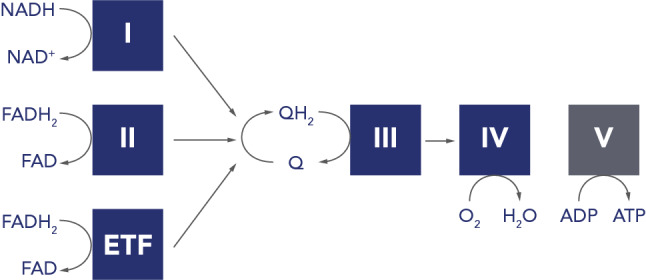Fig. 3.

Schematic diagram of the reduction of ubiquinone. The complete oxidation of pyruvate generates 4 NADH molecules and 1 FADH2, which are oxidised on complex I (I; NADH: ubiquinone oxidoreductase) and complex II (II; succinate: ubiquinone oxidoreductase) of the mitochondrial electron transport chain, respectively, while reducing ubiquinone (Q) to ubiquinol (QH2). In contrast, one round of β-oxidation also forms 4 NADH, but 2 FADH2. The second FADH2 is oxidised by the electron transfer flavoprotein: ubiquinone oxidoreductase (ETF), which also contributes to the QH2 pool. Additionally, the two mitochondrial dehydrogenases glycerol 3-phosphate dehydrogenase and dihydroorotate dehydrogenase (both not shown) can contribute to the QH2 pool as part of glycerol metabolism and the de novo pyrimidine biosynthesis pathway, respectively. QH2 is oxidised at complex III (coenzyme Q: cytochrome c oxidoreductase). Oxygen is reduced to water at complex IV (IV; cytochrome c oxidase). An ATPase synthase (V) synthesises ATP from ADP at Pi)
